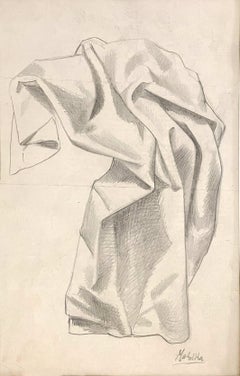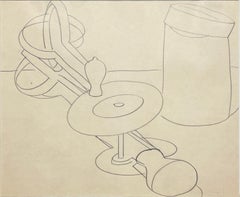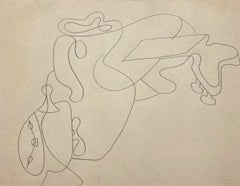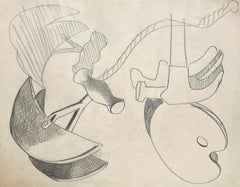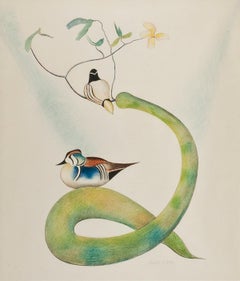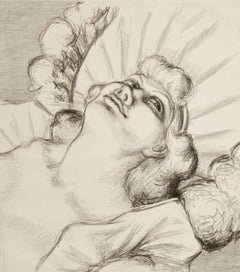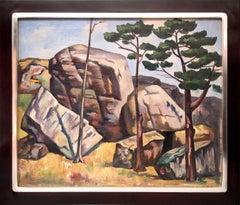Jan Matulka Art
American, 1890-1972
Matulka studied at the National Academy of Design before traveling to the American Southwest, where he grew inspired by Native-American and Hispanic cultures. Matulka used this inspiration upon returning home to create representational yet distorted artworks. Matulka fluidly oscillates between abstraction and figural painting. He has had many solo exhibitions across NYC and has had his work displayed in notable locations such as The Brooklyn Museum, the Museum of Modern Art, the Whitney Museum of American Art, the Guggenheim Museum, and the Smithsonian American Art Museum.(Biography provided by Rafael Gallery)
to
1
12
4
9
1
7
2
1
Overall Height
to
Overall Width
to
11
7
6
3
2
2
2
2
2
1
1
1
1
1
1
12
4
5
1
12
6,886
3,210
2,514
1,217
8
7
6
3
2
Artist: Jan Matulka
Untitled (Study of Classical Drapery)
By Jan Matulka
Located in Chicago, IL
A graphite on paper, study of a classical drapery by artist Jan Matulka. The image is drawn on the back of a typewritten, folded sheet of stationery, from Dyer, Hudson & Co., New Yo...
Category
1930s American Modern Jan Matulka Art
Materials
Paper, Graphite
Spanish Woman with Guitar
By Jan Matulka
Located in New York, NY
Jan Matulka (1890-1972), Spanish Woman with Guitar, lithograph, 1925, an unsigned proof impression. Reference: Flint 13, only a few impressions known...
Category
1920s American Modern Jan Matulka Art
Materials
Lithograph
Still Life with Egg Beater
By Jan Matulka
Located in Chicago, IL
A graphite on pencil drawing of Surrealist still life of an egg beater by artist Jan Matulka.
A leading Modernist, Jan Matulka was born in Prague Czechoslovakia in 1890. He studied...
Category
1930s Modern Jan Matulka Art
Materials
Graphite, Paper
Still Life with Alarm Clock and Mandolin
By Jan Matulka
Located in Chicago, IL
A graphite on pencil drawing of Surrealist still life of an egg beater by artist Jan Matulka.
A leading Modernist, Jan Matulka was born in Prague Czechoslovakia in 1890. He studied...
Category
1930s Modern Jan Matulka Art
Materials
Graphite, Paper
Still Life with Hammer, Palette and Chopper
By Jan Matulka
Located in Chicago, IL
A graphite on pencil drawing of Surrealist still life of an egg beater by artist Jan Matulka.
A leading Modernist, Jan Matulka was born in Prague Czechoslovakia in 1890. He studied...
Category
1930s Modern Jan Matulka Art
Materials
Graphite, Paper
Still Life with Profile and Hanger
By Jan Matulka
Located in Chicago, IL
A graphite on pencil drawing of Surrealist still life of an egg beater by artist Jan Matulka.
A leading Modernist, Jan Matulka was born in Prague Czechoslovakia in 1890. He studied...
Category
1930s Modern Jan Matulka Art
Materials
Graphite, Paper
Abstraction
By Jan Matulka
Located in Chicago, IL
A handsome black & white abstraction by artist Jan Matulka.
Jan Matulka was an important Modernist that worked with artist Stuart Davis in creating a new form of Cubism, that was ba...
Category
1950s American Modern Jan Matulka Art
Materials
Ink, Graphite
Recto: "Cubist City Scene" Verso: "Pineapple Still Life"
By Jan Matulka
Located in New York, NY
Recto: ‘Cubist City Scene’ Verso: ‘Pineapple Still Life’ by Jan Matulka (1890-1972)
Pencil, colored pencil, and watercolor on paper
14 ¼ x 27 ½ inches unfr...
Category
20th Century Modern Jan Matulka Art
Materials
Watercolor, Pencil
New England Landscape
By Jan Matulka
Located in New York, NY
New England Landscape, 1925, by Jan Matulka (1890-1972)
Oil on canvas, mounted to masonite
29 ¼ x 21 ¾ inches unframed (74.295 x 55.245 cm)
30 x...
Category
Early 20th Century Cubist Jan Matulka Art
Materials
Acrylic
Jan Matulka VIEW OF THE BRONX Watercolor American Modern NYC 20th Century
By Jan Matulka
Located in New York, NY
VIEW OF THE BRONX Watercolor American Modern Modernism NYC 20th Century Drawing.
Jan Matulka (1890 – 1972) "View of the Bronx," 15 x 20 inches. Watercolor on paper, c. 1920s. Signed lower Right.
In 1907, he came to the Bronx, New York where he had a poverty-ridden childhood with a mother who tried to raise a family by herself. From 1908 to 1917, he studied at the National Academy of Design, and in 1917, received the first Pulitzer Traveling Scholarship with which he traveled and painted in the Southwest and Florida. His work from this period showed a turning towards a more abstract style, replacing his earlier realism.
In 1919, he first went to Paris and then returned in 1927 on a scholarship from the National Academy. In Paris, he was exposed to Cubism, and his painting after that seemed always to carry that influence. He had his first one-man exhibit in New York City in 1925, and by 1930, he and Davis were experimenting with their version of Cubism.
Concurrently for New Masses, a communist magazine, he did satiric illustrations expressing his sympathy for the working classes, and from 1929 to 1931, he taught at the Art Students League where he inspired emerging modernists such as David Smith, Dorothy Dehner, and I Rice...
Category
1920s American Modern Jan Matulka Art
Materials
Paper, Watercolor, Graphite
Four Nudes in a Landscape
By Jan Matulka
Located in New York, NY
Jan Matulka (1890-1972), Four Nudes in a Landscape, drypoint, c. 1923, signed in pencil lower right margin [also with initials in the plate lower left]. Ref...
Category
1920s American Modern Jan Matulka Art
Materials
Drypoint
Three-Quarter View of Nude Bathing Seated Near Lamp
By Jan Matulka
Located in New York, NY
Jan Matulka (1890-1972), Three-Quarter View of Nude Bathing Seated Near Lamp, lithograph, 1925, signed and dated in pencil lower right. Reference: Flint 9...
Category
1920s American Modern Jan Matulka Art
Materials
Lithograph
Related Items
Two Wood Ducks on a Flowering Branch
By Joseph Stella
Located in New York, NY
Joseph Stella was a visionary artist who painted what he saw, an idiosyncratic and individual experience of his time and place. Stella arrived in New York in 1896, part of a wave of Italian immigrants from poverty-stricken Southern Italy. But Stella was not a child of poverty. His father was a notary and respected citizen in Muro Locano, a small town in the southern Appenines. The five Stella brothers were all properly educated in Naples. Stella’s older brother, Antonio, was the first of the family to come to America. Antonio Stella trained as a physician in Italy, and was a successful and respected doctor in the Italian community centered in Greenwich Village. He sponsored and supported his younger brother, Joseph, first sending him to medical school in New York, then to study pharmacology, and then sustaining him through the early days of his artistic career. Antonio Stella specialized in the treatment of tuberculosis and was active in social reform circles. His connections were instrumental in Joseph Stella’s early commissions for illustrations in reform journals.
Joseph Stella, from the beginning, was an outsider. He was of the Italian-American community, but did not share its overwhelming poverty and general lack of education. He went back to Italy on several occasions, but was no longer an Italian. His art incorporated many influences. At various times his work echoed the concerns and techniques of the so-called Ashcan School, of New York Dada, of Futurism and, of Cubism, among others. These are all legitimate influences, but Stella never totally committed himself to any group. He was a convivial, but ultimately solitary figure, with a lifelong mistrust of any authority external to his own personal mandate. He was in Europe during the time that Alfred Stieglitz established his 291 Gallery. When Stella returned he joined the international coterie of artists who gathered at the West Side apartment of the art patron Conrad Arensberg. It was here that Stella became close friends with Marcel Duchamp.
Stella was nineteen when he arrived in America and studied in the early years of the century at the Art Students League, and with William Merritt Chase, under whose tutelage he received rigorous training as a draftsman. His love of line, and his mastery of its techniques, is apparent early in his career in the illustrations he made for various social reform journals. Stella, whose later work as a colorist is breathtakingly lush, never felt obliged to choose between line and color. He drew throughout his career, and unlike other modernists, whose work evolved inexorably to more and more abstract form, Stella freely reverted to earlier realist modes of representation whenever it suited him. This was because, in fact, his “realist” work was not “true to nature,” but true to Stella’s own unique interpretation.
Stella began to draw flowers, vegetables, butterflies, and birds in 1919, after he had finished the Brooklyn Bridge series of paintings, which are probably his best-known works. These drawings of flora and fauna were initially coincidental with his fantastical, nostalgic and spiritual vision of his native Italy which he called Tree of My Life (Mr. and Mrs. Barney A. Ebsworth Foundation and Windsor, Inc., St. Louis, illus. in Barbara Haskell, Joseph Stella, exh. cat. [New York: Whitney Museum of American Art, 1994], p. 111 no. 133).
Two Wood Ducks...
Category
20th Century American Modern Jan Matulka Art
Materials
Color Pencil
Burlesque Girl.
Located in Storrs, CT
Lloyd William Wulff. Burlesque Girl. 1938. Lithograph. 10 1/4 x 11 3/8 (sheet 12 1/2 x 15 1/8). Edition 28, #16. Federal Arts Project blind stamp. Printed on cream wove paper with fu...
Category
Mid-20th Century American Modern Jan Matulka Art
Materials
Lithograph
Five Morandi Bottles (Abstract Black-and-White Still Life Drawing in Graphite)
By David Dew Bruner
Located in Hudson, NY
Abstract black-and-white still life drawing of bottles on a surface by David Dew Bruner
graphite on paper
19.5 x 38.5 x 1.75 inches
Framed in vintage frame, hangs flush to the wall
...
Category
2010s Contemporary Jan Matulka Art
Materials
Paper, Graphite
David Dew BrunerFive Morandi Bottles (Abstract Black-and-White Still Life Drawing in Graphite), 2023
H 19.5 in W 38.5 in D 2 in
Time After Time.
By Ann Chernow
Located in Storrs, CT
Lithograph with watercolor. 22 3/8 x 30 5/8. Edition 56 (plus 5 artist's proofs). A bright impression printed on the full sheet of Arches paper. Signed and numbered 4/56 in pencil.
...
Category
Late 20th Century American Modern Jan Matulka Art
Materials
Watercolor, Color, Lithograph
Original "Poteries Culinaires" vintage French cooking poster
Located in Spokane, WA
POTERIES CULINAIRES; artist: Eugene Vavasseur (1863 - 1949) antique French stone lithograph. Excellent condition. Linen backed and ready to frame.
Original, archival linen back...
Category
Mid-20th Century American Modern Jan Matulka Art
Materials
Lithograph
H 31 in W 23 in D 0.05 in
Watercolor Still life Painting Vegetables Claus Hoien Greengrocer Kitchen Series
Located in Surfside, FL
Delicate watercolor of vegetables. Japanese eggplant and radishes and a squash gourd.
Framed 18 X 20 image is 11 X 13.5
Claus Hoie was a Norwegian-American...
Category
20th Century American Modern Jan Matulka Art
Materials
Watercolor
Large George Grosz 1923 Lithograph Die Rauber German Expressionism WPA Realism
By George Grosz
Located in Surfside, FL
From The robbers. lithographs by George Grosz for the drama of the same name.
photolithography on watermarked paper. 19 X 25.5 inches (sheet size). This is not hand signed or numbe...
Category
1930s American Modern Jan Matulka Art
Materials
Lithograph
Original 'I Am Telling You vintage Uncle Sam poster War Savings Stamps
By James Montgomery Flagg
Located in Spokane, WA
Original I Am Telling You, On June 28th, I expect you to enlist vintage poster. James Montgomery Flagg, WW1 original vintage World War 1 poster...
Category
1910s American Modern Jan Matulka Art
Materials
Lithograph
H 30 in W 20.25 in D 0.05 in
Large George Grosz 1923 Lithograph Die Rauber German Expressionism WPA Realism
By George Grosz
Located in Surfside, FL
From The robbers. lithographs by George Grosz for the drama of the same name.
photolithography on laid paper. 19 X 25.5 inches (sheet size). This is not hand signed or numbered in ...
Category
1930s American Modern Jan Matulka Art
Materials
Lithograph
Morandi 17: Abstract Cubist Style Morandi Bottle Still Life Pencil Drawing
By David Dew Bruner
Located in Hudson, NY
Abstract cubist style still life graphite drawing inspired by Giorgio Morandi's bottle paintings
"Morandi 17” by Hudson Valley artist, David Dew Bruner, made in 2023
Graphite on pap...
Category
2010s Abstract Jan Matulka Art
Materials
Paper, Graphite
H 24 in W 27.5 in D 2 in
Morandi 14: Contemporary Still Life Graphite Drawing of Bottles in Vintage Frame
By David Dew Bruner
Located in Hudson, NY
"Morandi 14” by Hudson Valley artist, David Dew Bruner, made in 2023
Graphite and acrylic on paper in an antique frame
Abstract cubist style still life graphite drawing inspired by G...
Category
2010s Abstract Jan Matulka Art
Materials
Paper, Acrylic, Graphite
Large George Grosz 1923 Lithograph Die Rauber German Expressionism WPA Realism
By George Grosz
Located in Surfside, FL
From The robbers. lithographs by George Grosz for the drama of the same name.
photolithography on watermarked paper. 19 X 25.5 inches (sheet size). This is not hand signed or numbe...
Category
1930s American Modern Jan Matulka Art
Materials
Lithograph
Previously Available Items
Bather (Nude Bather, Seated, Facing Window).
By Jan Matulka
Located in Storrs, CT
1925. Lithograph. Flint 7. 14 1/8 x 10 3/4 (sheet 18 9/16 x 12 3/8). Very few impressions; no published edition. Fine impression apart from vertical uneven printing line. Printed on ...
Category
1920s American Modern Jan Matulka Art
Materials
Lithograph
1920s Modernist Mountain Landscape, Framed Colorado Oil Painting, 25 x 30 inches
By Jan Matulka
Located in Denver, CO
A modernist mountain landscape (likely of Colorado) vintage 1930s oil painting by Jan Matulka (1890-1972). Sogmed nu tje artist in the lower right, estate stamped verso. Custom hand-carved frame measuring 30 x 35 inches, canvas size is 25 x 30 inches.
Expedited and International shipping is available - please contact us for a quote.
Provenance: Estate of the artist, Jan Matulka
About the Artist:
By maintaining his Czech birthright and European ties, Jan Matulka played a distinctive role in the development of American modernism. Participating in significant artistic circles in this country and France, he was an enthusiastic emissary of Cubism and Surrealism to both colleagues and students. His independent spirit worked against a successful art career, and personal misfortune and deafness increasingly cut him off from the emerging avant-garde scene. While Matulka experienced a renewed interest in his work before his death, his legacy as an inexhaustible creative force is only now appreciated.
Born on a dairy farm in South Bohemia in 1890, Matulka first pursued his artistic ambitions in Prague, an advanced cultural center that quickly embraced Cubist art and architecture. The intellectual vanguard supported a national revival, which included an interest in folk tales and traditions. For the young Czech artist, the simplified yet dynamic forms of Cubism and folk arts would become a liberating vocabulary, one he could apply to the sturdy underpinnings of traditional education. Throughout the many turns of his artwork, Matulka always brought a firm sense of design and command of drawing to his imaginative musings.
Arriving in the Bronx with his family in 1907, he began studies the following year at the conservative National Academy of Design, winning the $1500 Joseph Pulitzer Traveling Scholarship upon graduation. Because of the war, his artistic pilgrimage to Picasso’s Spain was stymied. So he traveled to those areas of the US that were settled by the Spanish, such as Florida, Arizona and New Mexico. While in the Southwest, he found a contemporary equivalent of the “primitive” in pueblo, living for a time with the Hopi. Along with naturalistic watercolors, his work stemming from this period is considered among the first modernist interpretations of Southwestern Indian customs.
Some of these works were finished from sketches upon his return to New York, where he started to fully express the formalist experimentation of Cubism. In the summer of 1920, Matulka exhibited abstract paintings at Katherine Dreier’s Societe Anonyme along with Patrick Bruce, James Daugherty and Jay Van Everen. Through her largesse, he would have a one-man show in 1926 at the Art Center, 65 East 56th Street, but his thoughtless behavior led to her losing interest in his fortunes.
Also upon his return to New York, he married Lida Jirouskova, a librarian whose literary connections led to illustration projects for Matulka. Studying lithography at the Art Students League in the mid-twenties solidified his understanding of graphic principles, and about half of his prints date from between 1925 and 1928. Working in black and white, Matulka developed an understanding of compositions based in shifting relationships of tonality – of contrast of dimension and design. This balance of the linear and the roughhewn characterize even the most colorful of his paintings.
Matulka and his wife traveled to Paris in late 1919 or early 1920, and he established a studio in Paris that he kept until 1934. Meeting with the likes of Gertrude Stein, he stayed current with the tastes of the aesthetic elite, such as Diaghilev’s Ballet Russe. Many of his works from this time are reminiscent of Picasso’s mix of neo-classical monumental nudes...
Category
1930s American Modern Jan Matulka Art
Materials
Canvas, Oil
H 30.25 in W 35.25 in D 1.25 in
Jan Matulka art for sale on 1stDibs.
Find a wide variety of authentic Jan Matulka art available for sale on 1stDibs. You can also browse by medium to find art by Jan Matulka in pencil, graphite, paper and more. Much of the original work by this artist or collective was created during the 20th century and is mostly associated with the modern style. Not every interior allows for large Jan Matulka art, so small editions measuring 1 inch across are available. Customers who are interested in this artist might also find the work of Winold Reiss, Gordon Grant, and William Zorach. Jan Matulka art prices can differ depending upon medium, time period and other attributes. On 1stDibs, the price for these items starts at $700 and tops out at $65,000, while the average work can sell for $875.
